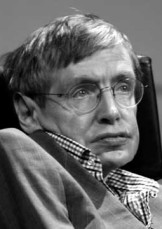STEPHEN HAWKING (1942 - 2018)

Stephen Hawking is a world-renowned British theoretical physicist, known for his contributions to the fields of cosmology, general relativity and quantum gravity, especially in the context of black holes. In the 1960s and 1970s, he worked on ground-breaking theorems regarding singularities within the framework of general relativity, and made the theoretical prediction that black holes should emit radiation (known today as Hawking radiation). He has also published several works of popular science in which he discusses his own theories and cosmology in general, including the runaway bestseller “A Brief History of Time”, and has come to be thought of as one of the greatest minds in physics since Albert Einstein. In his own words: “My goal is simple. It is complete understanding of the universe, why it is as it is and why it exists at all”.
Stephen William Hawking was born on 8 January 1942 in Oxford, England, in the middle of World War II. After his birth in the relative safety of Oxford, the family moved back to London, where his father headed the division of parasitology at the National Institute for Medical Research, despite the continued risk of bombing from the German air forces. In 1950, Hawking moved with his family to St. Albans, where he attended St. Albans High School for Girls from 1950 to 1953 (boys could attend until the age of 10), and from the age of 11, he attended St. Albans School, where he was a good, but not an exceptional, student.
In 1959, he won a scholarship to University College, Oxford, his father's old college, where he studied physics under Robert Berman (mainly because his own preference, mathematics, was not offered there), where he pursued his particular interests in thermodynamics, relativity, and quantum mechanics. Despite his sometimes lax study habits and his boredom with university life, he graduated in 1962 with a First Class BA degree.
After graduating from Oxford, he spent a short time studying sunspots at Oxford University’s observatory. However, he soon realized that he was more interested in theory than in observation, and left Oxford for Trinity Hall, Cambridge, where he studied for a time under Fred Hoyle, the most distinguished English astronomer of the time.
Soon after arriving at Cambridge, at the age of 21, Hawking started to develop the first symptoms of amyotrophic lateral sclerosis (ALS or “Lou Gehrig's disease”), a type of motor neurone disease which would eventually cost him almost all neuromuscular control. Although doctors predicted (incorrectly, as it turned out) that Hawking would not survive more than two or three years, he did gradually lose the use of his arms, legs and voice, until he was almost completely paralysed and quadriplegic.
Crucially, in 1965, he attended a lecture by the English mathematician Roger Penrose, who had recently produced a ground-breaking paper on space-time singularities (events in which the laws of physics seem to break down). Hawking became re-energized and engaged with renewed vigour in the study of theoretical astronomy and cosmology, particularly in the area of black holes and singularities. He would later collaborate with Penrose on several important papers on these subjects.
Another turning point in his life also occurred in 1965, with his marriage to a language student, Jane Wilde. With her help, and that of his doctoral tutor, Dennis Sciama, Hawking went on to complete his PhD and to become a Research Fellow and, later, a Professorial Fellow at Gonville and Caius College, Cambridge.
In 1968, he joined the staff of the Institute of Astronomy in Cambridge, where he remained until 1973, and began to apply the laws of thermodynamics to black holes by means of very complicated mathematics. In the late 1960s, he and his Cambridge friend and colleague, Roger Penrose, applied a new, complex mathematical model they had created from Albert Einstein's General Theory of Relativity which led, in 1970, to Hawking proving the first of many singularity theorems. This theorem provided a set of sufficient conditions for the existence of a singularity in space-time, and also implied that space and time would indeed have had a beginning in a Big Bang event, and would end in black holes. In effect, he had reversed Penrose's idea that the creation of a black hole would necessarily lead to a singularity, proving that it was a singularity that led to the creation of the universe itself.
In collaboration with Brandon Carter, Werner Israel and David Robinson, he provided a mathematical proof of John Wheeler's so-called "No-Hair Theorem", that any black hole is fully described by the three properties of mass, angular momentum and electric charge, and proposed the four laws of black hole mechanics, similar to the four classical Laws of Thermodynamics. From analysis of gamma ray emissions, he also suggested that primordial or “mini black holes” would have been formed after the Big Bang.
In 1974, Hawking and Jacob Bekenstein showed that black holes are not actually completely black, but that they should thermally create and emit sub-atomic particles, known today as Hawking radiation, until they eventually exhaust their energy and evaporate. This also resulted in the so-called “Information Paradox” or “Hawking Paradox”, whereby physical information (which roughly means the distinct identity and properties of particles) appears to be completely lost to the universe, in contravention of the accepted laws of physics. Hawking defended this paradox against the arguments of Leonard Susskind and others for thirty years, until famously retracting his claim in 2004.
These cutting edge achievements were made despite the increasing paralysis caused by Hawking's ALS. By 1974, he was unable to feed himself or get out of bed, and his speech became so slurred that he could only be understood by people who knew him well. In 1985, he caught pneumonia and had to have a tracheotomy, which left him unable to speak at all, although although a variety of friends and well-wishers collaborated in building him a device that enabled him to write onto a computer with small movements of his body, and then to speak what he had written using a voice synthesizer.
In 1973, he left the Institute of Astronomy for the Department of Applied Mathematics and Theoretical Physics and, in 1979, he was appointed Lucasian Professor of Mathematics at Cambridge University, a post he was to retain for 30 years until his retirement in 2009. He had three children with Jane Wilde: Robert (1967), Lucy (1969) and Timothy (1979), but the couple finally separated in 1991, reportedly due to the pressures of Hawking’s fame and his increasing disability.
Hawking’s ground-breaking research resulted in considerable fame and celebrity. In 1974, at the age of 32, he was elected as one of the youngest ever Fellows of the Royal Society. He was created a Commander of the Order of the British Empire (CBE) in 1982, and became a Companion of Honour in 1989. He has accumulated twelve honorary degrees, as well as many other awards, medals and prizes, including the Albert Einstein Award, the most prestigious in theoretical physics. He also became well-known among a wider audience, especially after his 1988 international bestselling book “A Brief History of Time”, and its follow ups “The Universe in a Nutshell” (2001) and “A Briefer History of Time” (2005).
He continued lines of research into exploding black holes, string theory, and the birth of black holesin our own galaxy. His work also increasingly indicated the necessity of unifying general relativityand quantum theory in an all-encompassing theory of quantum gravity, a so-called "theory of everything", particularly if we are explain what really happened at the moment of the Big Bang. As early as 1974, his theory of the emission of Hawking radiation from black holes was perhaps one of the first ever examples of a theory which synthesized, at least to some extent, quantum mechanicsand general relativity
Among the myriad other scientific investigations pursued by Hawking over the years are the study of quantum cosmology, cosmic inflation, helium production in anisotropic Big Bang universes, "large N" cosmology, the density matrix of the universe, the topology and structure of the universe, baby universes, Yang-Mills instantons and the S matrix, anti-de Sitter space, quantum entanglementand entropy, the nature of space and time and the arrow of time, spacetime foam, string theory, supergravity, Euclidean quantum gravity, the gravitational Hamiltonian, the Brans-Dicke and Hoyle-Narlikar theories of gravitation, gravitational radiation, holography, time symmetry and wormholes.
Never afraid to court controversy, he even began to question the Big Bang theory itself in the 1980s, suggesting that perhaps there never was a start and would be no end, but just change, a constant transition of one "universe" giving way to another through glitches in space-time. He developed his "No Boundary Proposal" in collaboration with the Amercian physicist Jim Hartle. Under classical general relativity, the universe either has to be infinitely old or had to have started at a singularity, but Hawking and Hartle’s proposal raises a third possibility: that the universe is finite but had no initial singularity to produce a boundary. The history of this no-boundary universe in "imaginary time" can perhaps be best envisaged using the analogy of the surface of Earth, with the Big Bangequivalent to Earth’s North Pole, and the size of the universe increasing with imaginary time as you head south toward the equator.
In 1995, Hawking married his nurse, Elaine Mason, although they divorced in 2006 amid unconfirmed rumours of physical abuse, and he has since made up his differences with his first wife, Jane. In 2003, Hawking became dangerously ill with pneumonia, before confounding his doctors once again by recovering and throwing himself ever more emphatically into his work.
In 2004, he dramatically reversed one of his earlier controversial claims about black holes (that they destroy everything that falls into them and that no information is ever retrieveable from a black hole), claiming new findings that could help solve the so-called “black hole information paradox”. In his new definition of black holes, the event horizon is not so well-delineated and may not completely hide everything within it from the outside, and he has embraced the concept of the multiverse to help explain the conservation of information in black holes.
Hawking's views on the existence of God have been the subject of much debate, especially since his 1988 "A Brief History of Time" in which he mused that the discovery of an overarching theory of everything would allow us to "know the mind of God", which some people have interpreted as literal and some as literary. However, in his 2010 book "The Grand Design" he states unequivocally that "spontaneous creation is the reason there is something rather than nothing, why the universe exists, why we exist. It is not necessary to invoke God...to set the universe going".
Hawking retired from his position as Lucasian Professor of Mathematics at Cambridge in 2009, in accordance with the University's retirement policy, and accepted a Distinguished Research Chair at the Perimeter Institute for Theoretical Physics in Waterloo, Canada. In the same year, he was awarded the Presidential Medal of Freedom, the highest civilian award in the United States.
Stephen Hawking died at age 76 on March 13, 2018.
Source: www.physicsoftheuniverse.com
Reader Comments
Newer articles
Older articles





























